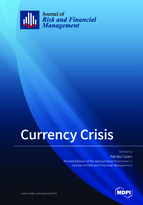Currency Crisis
A special issue of Journal of Risk and Financial Management (ISSN 1911-8074). This special issue belongs to the section "Banking and Finance".
Deadline for manuscript submissions: closed (28 February 2019) | Viewed by 34414
Special Issue Editor
Interests: energy; mathamatical modelling; energy finance; energy pricing; carbon pricing; time series analysis; forecasting
Special Issues, Collections and Topics in MDPI journals
Special Issue Information
Dear Colleagues,
The recent experience with bouts of financial crisis and the ever-rising possibility of another (perhaps more severe) one demands that academics across the globe—importantly those working in the area of economics and finance—take a serious look at the trends in the financial market, both at the national and global levels. It is our role and responsibility to present emerging facts that might point to the turn of event in the market which may produce another crisis in the not-too-distant future! The toll it takes on individuals and the nation is enormous and so painful that we need to come forward and act from a professional standpoint sooner rather than later.
In light of this concern, we are publishing a Special Issue focusing primarily on a potential financial/economic crisis. Several economists have been raising the red flag for some time. Our aim is to identify early signs of some economic booby-trap—if any—that lie ahead with a deep desire to ambush us. We believe that a set of serious academic papers by scholars of your demeanour would be valuable, with the ability to offer valuable insight, and perhaps guidance to the policy-makers to stay prepared early on, prompting them to be ready with the necessary tools to respond to the eventuality, should such a possibility even arise. Such preparedness will enable us to avoid one, or keep the adverse effect at minimal, before we have to confront the reality of being struck by the crisis. Both theoretical and empirical papers are welcome.
Please consider submitting an article for publication in this journal, which strictly follows a double-blind review process to ensure quality. Please note that we are offering a very broad latitude for authors to accommodate papers from a wide array in the discipline. Should you have questions, please feel free to address them to me.
Thank you!
Sincerely,
Dr. Faridul IslamGuest Editor
Manuscript Submission Information
Manuscripts should be submitted online at www.mdpi.com by registering and logging in to this website. Once you are registered, click here to go to the submission form. Manuscripts can be submitted until the deadline. All submissions that pass pre-check are peer-reviewed. Accepted papers will be published continuously in the journal (as soon as accepted) and will be listed together on the special issue website. Research articles, review articles as well as short communications are invited. For planned papers, a title and short abstract (about 100 words) can be sent to the Editorial Office for announcement on this website.
Submitted manuscripts should not have been published previously, nor be under consideration for publication elsewhere (except conference proceedings papers). All manuscripts are thoroughly refereed through a single-blind peer-review process. A guide for authors and other relevant information for submission of manuscripts is available on the Instructions for Authors page. Journal of Risk and Financial Management is an international peer-reviewed open access monthly journal published by MDPI.
Please visit the Instructions for Authors page before submitting a manuscript. The Article Processing Charge (APC) for publication in this open access journal is 1400 CHF (Swiss Francs). Submitted papers should be well formatted and use good English. Authors may use MDPI's English editing service prior to publication or during author revisions.
Keywords
- E3 Prices, Business Fluctuations, and Cycles
- E32 Business Fluctuations
- Cycles
- E44 Financial Markets and the Macroeconomy
- E5 Monetary Policy, Central Banking, and the Supply of Money and Credit
- E52 Monetary Policy
- E58 Central Banks and Their Policies
- E6 Macroeconomic Policy, Macroeconomic Aspects of Public Finance, and General Outlook
- E63 Comparative or Joint Analysis of Fiscal and Monetary Policy
- Stabilization
- Treasury Policy
- E65 Studies of Particular Policy Episodes
- F. International Economics
- F00 General
- F01 Global Outlook
- F02 International Economic Order and Integration
- F13 Trade Policy
- International Trade Organizations
- F14 Empirical Studies of Trade
- F15 Economic Integration
- F2 International Factor Movements and International Business
- F20 General
- F21 International Investment
- Long-Term Capital Movements
- F3 International Finance
- F31 Foreign Exchange
- F32 Current Account Adjustment
- Short-Term Capital Movements
- F33 International Monetary Arrangements and Institutions
- F34 International Lending and Debt Problems
- F36 Financial Aspects of Economic Integration
- F37 International Finance Forecasting and Simulation: Models and Applications
- F38 International Financial Policy: Financial Transactions Tax
- Capital Controls
- F4 Macroeconomic Aspects of International Trade and Finance
- F41 Open Economy Macroeconomics
- F42 International Policy Coordination and Transmission
- F44 International Business Cycles
- F45 Macroeconomic Issues of Monetary Unions
- F53 International Agreements and Observance
- International Organizations
- F55 International Institutional Arrangements
- F6 Economic Impacts of Globalization
- F60 General
- F61 Microeconomic Impacts
- F62 Macroeconomic Impacts
- F63 Economic Development
- G. Financial Economics
- G00 General
- G01 Financial Crises
- G1 General Financial Markets
- G11 Portfolio Choice
- Investment Decisions
- G15 International Financial Markets
- G2 Financial Institutions and Services
- G23 Non-Bank Financial Institutions
- Financial Instruments
- Institutional Investors
- G28 Government Policy and Regulation
- G29 Other





